 |
|

|
 |
TABLE of CONTENTS
 |
Project update: Hwy 14 project in North Mankato to improve safety, mobility |
By Rebecca Arndt, District 7 Public Affairs
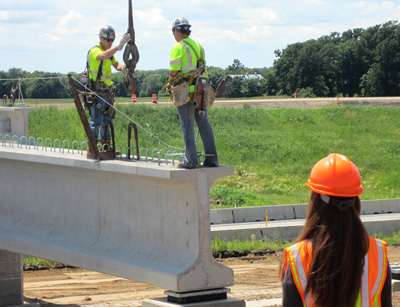
Angel Staples (lower right), bridge engineer, observes the Hwy 14 bridge construction project July 23 in North Mankato. Photo by Rebecca Arndt |
The Hwy 14 interchange project in North Mankato is in full swing and is on schedule to be completed this fall. This is the second year of the two-phase project. More than 9,500 vehicles traveled on the highway per day in 2000, with 19,500 - 21,900 projected by 2020.
“Progressing on the bridge right now is critical to completing the project on time,” said project supervisor Adam Schendel. “We are catching up from the wet spring and pleased to have the beams set.”
The bridge design team, led by Angel Staples, visited the project site on July 23 and observed the bridge construction.
“We learned a lot from our visit,” said Staples. “We always look for ways to make improvements in our design in order to ensure the construction of our bridges goes as efficiently as possible. We really value our connections to the MnDOT construction personnel and we take their feedback to heart.”
Project highlights
- Turn two miles of Hwy 14 into a four-lane divided highway between County Road 6 in Belgrade Township and Lookout Drive in North Mankato
- Construct an interchange at Nicollet County Road 41
- Construct roundabouts at ramp terminals
- Turn existing Hwy 14 into a frontage road between County Road 6 and County Road 41
Benefits
- Improve access along Hwy 14 corridor
- Reduce overall traffic congestion
- Improve overall safety and mobility
In addition to improving access and reducing congestion, the project also will make a number of improvements that support accessibily requirements in the Americans with Disabilities Act, including:
- Extending the trail from Nicollet County Road 41 from south of Pleasant View to north of Howard Drive
- Adding curb cuts and truncated domes to the trail
- Constructing roundabouts on each end of the interchange to accommodate pedestrian crossings
“Naturally, we are looking forward to seeing the bridge in service and we will take great pride in knowing the end product meets the needs of the district, local community and the travelling public,” said Staples.
For more information about the Hwy 14 project in North Mankato, visit: mndot.gov/d7/projects/14northmankato/index.html.
|
 |
|

|
 |
TABLE of CONTENTS
 |
CO employees assist in Central Corridor Light Rail survey |
By Rich Kemp
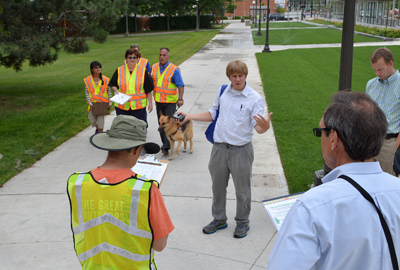
Harry Kent (in middle), District Councils Collaborative, discusses a walkability survey with MnDOT employees July 25 at the Capitol/Rice Street station for the Central Corridor Light Rail Green Line. The group filled out a survey and provided ideas for improvements in the pedestrian accessibility. Photo by Rich Kemp |
Central Office employees helped evaluate the pedestrian experience along the future Central Corridor Light Rail Metro Green Line as part of a walkability survey the District Councils Collaborative of Saint Paul and Minneapolis conducted in July.
Located on University Avenue one block north of the Transportation Building, the Capitol/Rice Street station is part of the Green Line, which is scheduled to open in 2014.
The employees walked a path between the Transportation Building and the Capitol/Rice Street station with Harry Kent from the District Councils Collaborative. After the walk, the group filled out a survey and provided ideas of what improvements can be made and what is already working well in the pedestrian environment. DCC conducted two separate walkability sessions with Capitol area employees.
"We have received over 60 surveys as well as helpful feedback for fixing the infrastructure,” said Kent. “We are excited about taking this information to our local partners and making changes to improve pedestrian accessibility for all."
This program supports MnDOT's Complete Streets goal for a multimodal transportation system that is safe and accessible for all users. The DCC will use the data to identify what areas to focus on to make the Green Line accessible and safe for all users and to improve community health. The DCC will present the information to District Council members and local government officials with suggested improvements.
“The participants were interested and thoughtful, representing a range of MnDOT functional areas, as well as non-MnDOT employees,” said Carol Zoff, senior landscape architect. “It was easy to complete over the lunch hour, resulting in a lesson for the participants and information for property managers and area planners to act upon.”
Transportation models forecast 40,000 weekday riders by 2030. Models also predict that 68 percent of all Green Line riders will be walking to their stations and that riders may walk as much as a half-mile or more to reach their station.
Learn more about the walkability survey at:
www.dcc-stpaul-mpls.org/special-projects/walk
For more information about the Metro Transit lines, visit www.metrotransit.org/metro-system. |
 |
|

|
 |
TABLE of CONTENTS
 |
Next round of research projects take shape |
|
By Nick Busse, Research Services
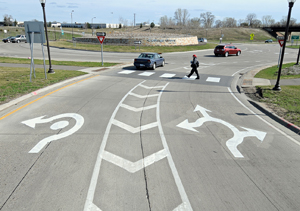
A potential study on the safety and mobility of two-lane roundabouts is among the many research need statements released as part of this year’s research RFP. Photo by David Gonzalez |
MnDOT Research Services has released its 2013 request for proposals, providing an early glimpse into Minnesota’s next round of potential transportation research projects.
In all, the 2013 RFP included 25 research need statements in six different strategic areas. They address a wide range of topics — everything from intersection conflict warning systems to the traffic impacts of bike lanes. The full list is available online, with links to each individual statement.
“This year’s RFP solicitation represents a broad cross-section of transportation priorities, and will help meet the needs of both MnDOT and local practitioners,” said Research Management Engineer Hafiz Munir.
Each year, Research Services and the Local Road Research Board solicit ideas for new research projects. Those ideas are independently reviewed and prioritized by the LRRB and MnDOT’s Transportation Research Innovation Group, which is made up of leaders from MnDOT districts and specialty offices.
The research need statements are developed based on priorities identified by TRIG and the LRRB, and then released for the RFP.
“We use a process that is open to everybody,” Munir said. “It is a lot of work, but I feel happy that we use this process. It helps involve all of the stakeholders in the decision-making.”
The current RFP solicitation is open to faculty from universities with MnDOT master contracts, as well as MnDOT’s own Office of Materials and Road Research. Academic research proposals are due by Sept. 17, 2013. Once they’re collected, TRIG and the LRRB will evaluate them and make funding recommendations.
Fiscal Year 2015 funding awards will be announced this December. Ideas for future research projects can be submitted through the Minnesota Transportation Research Collaboration Website. |
 |
|

|
 |
TABLE of CONTENTS
 |
MnDOT staff visit Oshkosh Air Show |
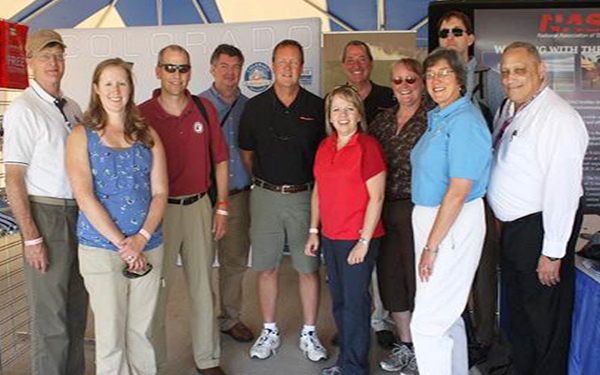
The Experimental Aircraft Association held its 61st annual convention from July 29 through Aug. 4 at Wittman Regional Airport in Oshkosh, Wis. Agency staff attended the event to meet with Federal Aviation Administration representatives and connect with other state transportation agencies. From left: Barry Erickson, MnDOT pilot; Rachel Obermoller, MnDOT pilot; Tim Henkel, Modal Planning and Program Management Division director; Dan Boerner, Aeronautics Eengineer; Tom Booth, chairman, National Association of State Aviation Officials; Henry Ogrodzinski, chief executive officer, National Association State Aviation Officials; Cassandra Isackson, Aeronautics director; Kathy Vesley, Aeronautics planner; Ryan Juran, Aeronautics planner; Sue Mulvahill, deputy commissioner/chief engineer; and Dan McDowell, Aeronautics public affairs coordinator. Photo courtesy of NASAO |
|
 |
|

|
 |
TABLE of CONTENTS
 |
Kim Collins named Office of Civil Rights director |
|
By TK Kramascz
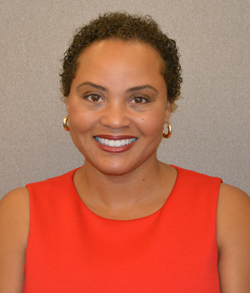
Kim Collins is the new Office of Civil Rights director for MnDOT. Photo by Rich Kemp |
As part of MnDOT’s new organizational structure, Commissioner Charlie Zelle on July 26 appointed Kim Collins as director of the Office Civil Rights.
Collins will report to the agency’s chief counsel, Betsy Parker.
“This reporting relationship reflects the agency’s continued commitment to the mission of the Office of Civil Rights, which is to ensure equal opportunity for all businesses and personnel on our projects,” said Zelle.
Collins is a licensed attorney and has been with MnDOT since 2004. She’s spent the past three years in the Office of the Chief Counsel, where she provided legal advice about the requirements of state and federal law for each program that OCR manages.
Prior to that, Collins spent six years in the agency’s Affirmative Action Office, where she worked closely with employees from across MnDOT, as well as with staff from the Minnesota Department of Human Rights and the Equal Employment Opportunity Commission.
Collins’s experience also includes working as an operations manager for a private development and construction firm as a human resources corporate staffing manager; a diversity and retention specialist; and a corporate auditor for a multi-national corporation.
OCR responsibilities include the administration of the disadvantaged business enterprise program, workforce and EEO programs, business development programs, and the DBE and Workforce Collaborative.
As director, Collins’s first task will be to review the office’s internal procedures to ensure compliance with the requirements of the programs the office manages.
“We will continue to identify opportunities to increase the effectiveness and efficiency of the office’s operations,” said Collins. “Meanwhile, we remain committed to our collaborative stakeholders. We recognize the important role of the Office of Civil Rights as a component in the overall delivery of MnDOT projects.”
Collins is located on the 7th floor at Central Office and can be reached at 651-366-3150.
Learn more about OCR by visiting the office’s website. |
 |
|

|
 |
TABLE of CONTENTS
 |
Metro District’s Luke Lorenz dies unexpectedly |

Luke Lorenz worked in the Metro District traffic control office and is survived by his wife, Karrie; daughters, Kadrian and Kiley. Photo provided by Lorenz family |
Luke Lorenz, Metro District traffic control, died unexpectedly July 9. He was 39.
Lorenz started working for MnDOT in July 2008 in the design section. In May 2011, he moved to the traffic section.
Lorenz served in the Minnesota National Guard as a second lieutenant with the 834th Aviation Support Battalion in Arden Hills.
“He was pretty friendly and a funny guy,” said Matt Schellhammer, who worked in the traffic office with Lorenz. “He was very dedicated to his wife and family.”
Lorenz enjoyed skateboarding, motorcycling, vacationing to Mexico and hanging out with his family.
He is survived by his wife, Karrie; daughters, Kadrian and Kiley.
Funeral services were held July 15 at Maranatha Assembly of God Church in Forest Lake. |
 |
|

|
 |
TABLE of CONTENTS
 |
Bernie Arseneau departs MnDOT after 30 years of service |
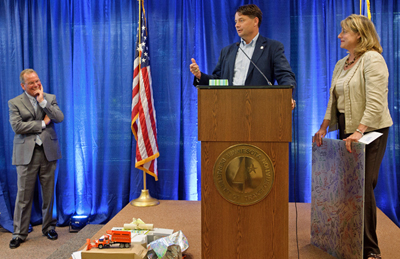
Steve Lund, state maintenance engineer, and Sue Groth, State traffic engineer, presented Bernie Arseneau with a gift at his retirement ceremony July 29. Photo by David Gonzalez |
Bernie Arseneau, deputy commissioner and chief engineer, resigned his position effective July 29 to take a position in the private sector.
He leaves MnDOT after 30 years of service to the state of Minnesota, a career that has included such roles as Policy, Safety & Strategic Initiatives Division director, state traffic engineer, area maintenance engineer, and tort claims and traffic standards engineer. Arseneau also helped establish Minnesota’s Toward Zero Deaths program in 2003, and has been a strong advocate for the initiative throughout its existence.
Arseneau, a registered professional engineer and a professional traffic operations engineer, has been active in a number of national engineering committees, including having served as chair of the AASHTO Subcommittee on Traffic Engineering, and as a member of the AASHTO standing committees on highways and on highway traffic safety.
“I want to take this opportunity to publicly thank Bernie for all he has done for MnDOT. He has had a long and illustrious career here. His efforts with TZD have saved many lives and have made MnDOT a national leader in road safety,” said Commissioner Charlie Zelle. “He has been a great mentor. He leaves behind a legacy of strong young leaders who will serve this agency well into the future.”
“How lucky we are to work for such a great organization,” Arseneau said in his parting note to MnDOT employees. “My whole career I have been so proud to tell family, friends and others that I work for MnDOT. The work we all do here makes a difference. It touches so many people every day and it impacts their quality of life in such a positive way. Imagine the number of people who make it home at night because of the cable barrier, expertly plowed and maintained roads, rumble strips, real time information, or any of the other leading ways MnDOT delivers the transportation system. They may not have recognized it, but your work was an integral part of their safe travels!”
See also Arseneau’s recent column about TZD:
|
 |
|

|
 |
TABLE of CONTENTS
 |
New option for truckers, other improvements made to 511 website |
By Kent Barnard, Metro District Public Affairs

The Minnesota Department of Transportation has made a few updates to the 511 website to include a page for truckers. |
Less than a month after the debut of its new 511 traveler information mobile application for smartphones, MnDOT has again improved the real-time service for truckers and others seeking the best route from Point A to Point B.
With the department’s new full-featured truckers’ page, over-the-road drivers will now be able to plot their trips from origin to destination. The new app, accessed from the 511 homepage, also will alert them to information about possible restrictions along their chosen route, including roundabouts, postings that prohibit overweight vehicles or lower bridge deck clearances. The program only works for trips within the state, although some neighboring states, including Iowa and North Dakota, have similar programs.
Truck drivers can personalize their routes to include numerous stops along the trip. Once an account is created, drivers enter their trip information and then will receive a response with details about their chosen route.
“The extra information feature targeted specifically to the trucking community will allow drivers to better plan their routes to move freight more efficiently through the state by avoiding potential obstacles,” said Ted Coulianos, oversize/overweight permit supervisor with MnDOT’s Office of Freight & Commercial Vehicle Operations.
Additional changes and upgrades make it possible for all travelers to use the trip routing feature found at www.511mn.org to plan trips around road construction and incidents on the highway system. By signing up for the new alerts feature, users receive personalized text and email messages containing real-time traffic alerts affecting the routes and areas they have saved to their account.
The low bandwidth site, for slower internet connections, also has been improved and now more closely mirrors the full-featured high bandwidth used by higher speed connections. Although still a static site, users will now find more concise listings of traffic information and larger, improved camera views. |
 |
|

|
 |
TABLE of CONTENTS
 |
On the Job: Joe Elsenpeter flags traffic in District 3 |
Joe Elsenpeter is a flagger from the Buffalo Truck Station. Bob Filipczak caught up with him near Montrose to find out what it is like to be a flagger. |
|
 |
|

|
|
| |
|



